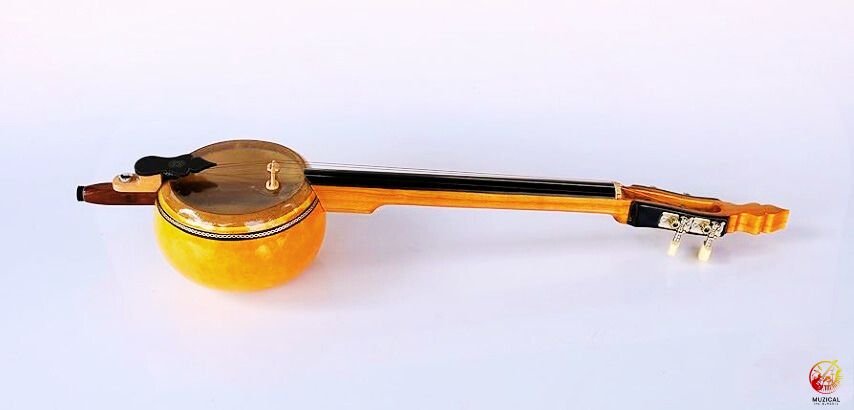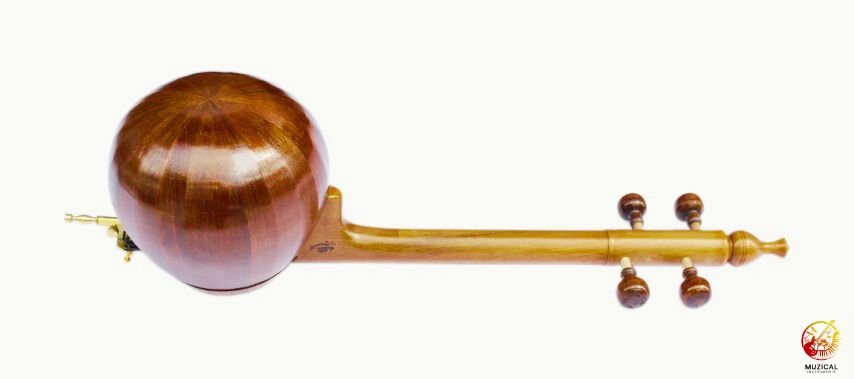Kabak Kemane vs Kamancheh: Deep Dive into Two Ancient Bowed Instruments
If you’re a music fan, you might have heard of the kabak kemane and the kamancheh. At first, they might look like the same instrument. They’re both string instruments played with a bow, and they both rest on the player’s knee. But a closer look shows how different they are.
This article is all about the kabak kemane vs kamancheh, and we’ll learn what makes each one special. We’ll talk about how they are made, what they sound like, and where they come from.
By the end, you’ll be able to tell these amazing instruments apart and understand why they are so important in their home countries of Turkey and Iran.
Kabak Kemane vs Kamancheh: A Quick Look
| Feature | Kabak Kemane | Kamancheh |
|---|---|---|
| Body Shape | Gourd (kabak) body | Carved wooden bowl |
| Strings | Usually 3, sometimes 4 strings | Usually 4 strings |
| Sound | Warm, deep, rustic, and emotional | Clear, bright, lyrical, and a bit nasal |
| Music Type | Turkish folk music | Persian classical music |
| Player Technique | Fingernails touch strings from the side | Fingertips press strings from above |
| Famous Players | Talip Özkan, Mustafa İsen | Kayhan Kalhor, Ardeshir Kamkar |
How are the kabak kemane and kamancheh made differently?


The way these instruments are built is the biggest reason they sound so different.
Kabak Kemane
Let’s start with the kabak kemane. Its name in Turkish means “pumpkin fiddle.” That’s because its body is a real gourd, which is like a big, hard pumpkin. This gourd is hollowed out and covered with a piece of animal skin, often from a fish. This special build gives the kabak kemane a deep, warm, and somewhat gentle sound.
It’s a very natural and earthy sound, which fits well with its folk music roots. It usually has three strings, but some modern players use four. The strings are held by a wooden neck, and the whole thing rests on your knee when you play it.


Kamancheh
Now, let’s look at the kamancheh. It’s also a kind of spiked fiddle, but its body is usually carved from wood like walnut or mulberry. The wooden body can be a single piece or many small pieces glued together. The top is a thin piece of skin, often lamb or goat hide. The kamancheh has a metal spike at the bottom that you rest on your knee.
This wooden body and different construction give it a clearer, brighter sound than the kabak kemane. Its sound is often described as a bit piercing or a bit nasal, which helps it stand out when played with other instruments.
What is the history of the kabak kemane and kamancheh?
The stories behind these instruments are as different as their sounds.


Kabak Kemane
The kabak kemane has a long history with the nomadic people of Central Asia. It’s a very old instrument that traveled with Turkic tribes as they moved. Over time, it became a key part of Turkish folk music, especially in places like the Aegean region. It was mainly a country instrument, something played at village weddings or parties. It was a way to share stories and feelings through music.
A well known organization, Turkish Radio and Television (TRT), helped make it more popular across the country by having it in their shows. Today, it’s a national treasure and a big part of Turkey’s culture.
Kamancheh
The kamancheh has a very different past. It comes from Persian classical music and was played in the royal courts of Iran for hundreds of years. The kamancheh is a very important part of Iranian culture. So important, in fact, that UNESCO has named the art of making and playing it as a world heritage.
The music played on the kamancheh is part of a system called dastgah, which has certain rules and moods. It’s a formal and deep kind of music that’s often tied to poetry and history. This makes the kabak kemane vs kamancheh a comparison of folk vs classical traditions. Famous kamancheh players, or virtuosos, like Kayhan Kalhor, have brought this instrument to a global audience.
How do people play these instruments?
The way you hold and play these instruments is different, even though they look similar.
Kabak Kemane
With the kabak kemane, the player holds the gourd on their knee. They use a bow, and instead of pressing the strings with their fingertips, they touch them from the side with their fingernails. This gives them a lot of control to make small changes in pitch, which is very important for Turkish music. They can also make the sound tremble, which adds a lot of emotion to the music.
Kamancheh
For the kamancheh, it is also held upright, with the spike resting on the player’s knee or thigh. The player uses a bow that can be tightened or loosened while playing to change the sound. This gives the player more control over the sound. The technique for playing notes on the kamancheh is a bit different and very exact. It’s all about creating the beautiful, flowing melodies and fast ornaments that you find in Persian classical music.
Both instruments are amazing, but the playing styles for a kabak kemane vs kamancheh are unique to each musical tradition.
What about the name? Is there a connection?
Yes, there is! The word kaman is a Persian word that means “bow.” The endings of the names, -cheh and -kemane, both mean “little.” So, both “kabak kemane” and “kamancheh” mean something like “little bow.” This shows that they came from a shared idea of a bowed string instrument.
But the word “kabak” in the Turkish name tells you that this instrument uses a gourd, which makes it special. The kabak kemane vs kamancheh is a great example of how similar names can be for very different things.
Can someone play both instruments well?
You might wonder if a musician could play both the kabak kemane and kamancheh. It’s possible to learn both, but mastering both is extremely hard. It would be like a guitarist who is a master of both classical guitar and electric blues guitar. They are both guitars, but the music, techniques, and even the feeling are very different.
A musician would have to spend years studying each instrument’s style. For example, the specific rhythms and notes in Turkish tavr are not the same as the modes and phrases of Persian dastgah.
So, while a good musician could probably play a simple tune on both, being a true master of both the kabak kemane vs kamancheh is a huge challenge.
How do you care for and maintain kabak kemane vs kamancheh?
Both need careful attention to wood, skin, and strings, common sense matters.
Humidity and temperature
- Ideal: 40–55% humidity.
- Too dry: Skin can crack; wood splits.
- Too humid: Skin sags, tone muffles.
Skin tuning
- Kabak kemane skins might need tightening before performances.
- Kamancheh skins are more stable but still need seasonal checks.
String care
- Use rosin on bow hair.
- Keep strings clean with a soft cloth after playing.
Bow hair
- Loosen after each use.
- Rehair every 6–12 months, depending on wear.
Pro Tip: Avoid storing in hot cars or near radiators. A breathable gig bag or case keeps the instrument safe and prolongs its life.
Final Thoughts: What’s the big difference between the kabak kemane and the kamancheh?
The main differences between the kabak kemane vs kamancheh come down to their materials and what kind of music they play.
The kabak kemane, with its gourd body, gives us a deep, earthy sound that is perfect for the heartfelt folk songs of Turkey.
The kamancheh, with its carved wooden body, has a bright, clear sound that is essential for the complex and beautiful classical music of Iran.
They may share a family tree as bowed fiddles, but they have grown into two completely unique and wonderful musical instruments.
If you want to learn more, you should listen to music played on both instruments. Look up the Turkish masters like Talip Özkan and the Iranian masters like Ardeshir Kamkar.
When you listen to a performance of the kabak kemane vs kamancheh, you’ll hear more than just music; you’ll hear the history and soul of two different cultures.
So go ahead, give them a listen and start your musical journey.
FAQ: Kabak Kemane vs Kamancheh
1. What is the main difference between kabak kemane and kamancheh?
The kabak kemane is a Turkish “pumpkin fiddle” with a gourd body and typically 3-metal-string setup, producing a sharp, bright tone. The kamancheh, from Iran/Azerbaijan, has a wooden bowl resonator, usually four silk or gut strings, delivering a warm, expressive sound.
2. Why is kabak kemane also called “pumpkin fiddle”?
Because kabak kemane literally means “gourd (kabak) bow (kemane)” in Turkish. Its resonator comes from a hollowed pumpkin (gourd), giving it a distinctive look and resonant voice.
3. Is kamancheh related to the kabak kemane?
Yes. Both instruments belong to the same bowed-string family and share a common ancestor (the rebab). In fact, some sources refer to the kabak kemane as a Turkish variation of the kamancheh.
4. How many strings do kabak kemane and kamancheh have?
Kabak kemane usually has 3 metal strings, though 4-string variants exist.
Kamancheh traditionally had 3 silk strings, but modern versions now usually have 4 silk, gut, or metal strings.
5. Are kabak kemane and kamancheh played the same way?
Not exactly. You hold both vertically, pressing against the knee, but:
Kabak kemane uses a straight bow.
Kamancheh uses a curved, variable-tension bow that wraps around the strings.
6. Which one weighs more: kamancheh or kabak kemane?
The kamancheh is heavier, typically 1–1.5 kg while the kabak kemane is lighter, around 400–500 g, because of its gourd body.
7. What music genres use kabak kemane vs kamancheh?
Kabak kemane shines in Turkish folk music, dance tunes, shepherd songs, village celebrations.
Kamancheh is central in Persian classical (dastgah), Azerbaijani mugham, and other regional classical styles.
